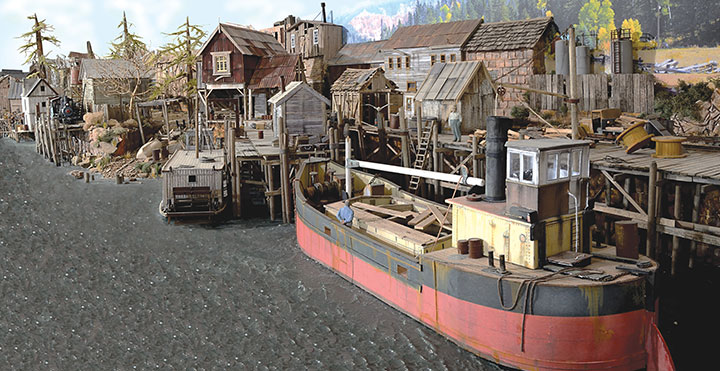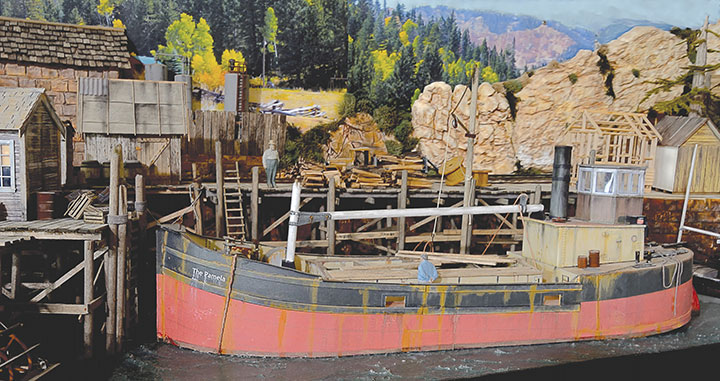Model railroaders seem to be attracted to harbors and like to model the interchange between ships and railroads. The thing with harbors and boats is that they tend to be large and can dominate even the largest layout. In my case, I had already built a timber stern wheeler. But my harbor still had some water waiting to be filled and I was always on the lookout for another boat of some sort. I’m one of those modelers who reads every model railroad magazine I can get my hands on including magazines from the United Kingdom. In one UK magazine, I came across an ad for Scalescenes (scalescenes.com) featuring a number of boats. On closer inspection I found they had a OO (4mm) scale kit for a small coastal freighter called a Clyde Puffer. But Scalescene kits are paper. So how would a paper kit do? But the Clyde Puffer was just what I was looking for my harbor — a small freighter that would fit in perfectly.


My layout is On30, so how could I take a OO scale paper kit and turn it into an O scale model? I decided to try, and ordered a Clyde Puffer. It cost all of £5.00. When you order a kit, you are given the procedure to download two PDF files that contain all the patterns and a full set of clear instructions. It’s simply a matter of printing out the PDFs and following the instructions. But remember it’s a OO scale kit. So, I had to do some calculations to get an O scale kit.
When printing a PDF, you are given File/Print. In the File/Print popup window you have a number of print size options. You need to use the Custom option. (Here’s a handy scale conversion site that may help — https://www.3dk.ca/re-size). So, as an example, to go from your 100 percent, OO scale, to O scale you need to put in 1.583 (check if your system needs the decimal point). But in my case, I found 1.583 was just a wee bit too big. So, I scaled back and used 1.5 to give me a slightly smaller boat. Be careful if you do this. You need to keep in mind the size of doors, and other details on your boat. It’s just a case of printing in your scale from that point. I also found the mast too high and tended to dominate the scene. So, my Puffer must have encountered heavy weather and the mast is broken. Scales smaller than S scale should be able to get a print on any printer that can print A3+ sizes. If you haven’t got a suitable printer, then I’m sure there is a nearby office supply store that you can get to print your plans. Just make sure they know the percentage to use. In my case, I have an A3+ printer, but even that wasn’t big enough for an O scale set of plans. But I fiddled around and printed the pages in sections. This can be fiddly but for me it worked. It basically gave me 2 sets of plans. When you have the PDFs, Scalescenes allows you to print as many times as you need. I also printed onto plain paper because it gives a nice dull/mat finish which suits a working boat. The first time I printed the plans I used just black ink thinking I would paint the boat. But this wasn’t a good idea because the paper didn’t like being painted. So, print in color. The plain paper in color gives a nice result. Remember if you make a mistake not all is lost. You simply print off the replacement parts you need. If you are using a professional printer, just get a few extra prints.
If you are thinking how does a flimsy paper boat last? Then don’t worry. Your paper parts need to be glued to various thicknesses of card stock. The instructions tell what thickness of card stock is needed for each part, such as heavy, medium or light. Each page will tell you what card stock weight you need to use. Simply cut out the part you need. Glue it to the card and then cut the card following the paper outline. I used Bostik, Blu Stik to glue the paper to the card.
So, £5.00 will get you two PDFs from Scalescenes containing 12 pages of instructions and 7 pages of parts.
I live in the sub tropics. It gets very hot and humid. After a number of years, there have been no issues with my Clyde Puffer. Folks looking at it are amazed that it’s made of paper. I added a few extra details from my scrap box, and my Puffer has timber for the hold covers rather than canvas. But those are details that you can change to suit your requirements.
The Scalescenes web site has the following information and a list of scale reductions. I have only listed the more common scales.
As long as your printer has the ability to scale pages up or down, there is no reason why you can’t build any of the kits in other scales. Your printer’s “Scaling” options is usually found in the “Advanced,” “Properties” or “Page Setup” section of your Adobe Reader print window. Please consult your printer’s “Help Index” for more details.
If you are modelling in HO (1:87) or N (International 1:160), all products on Scalescenes.com can be resized down using the table below: